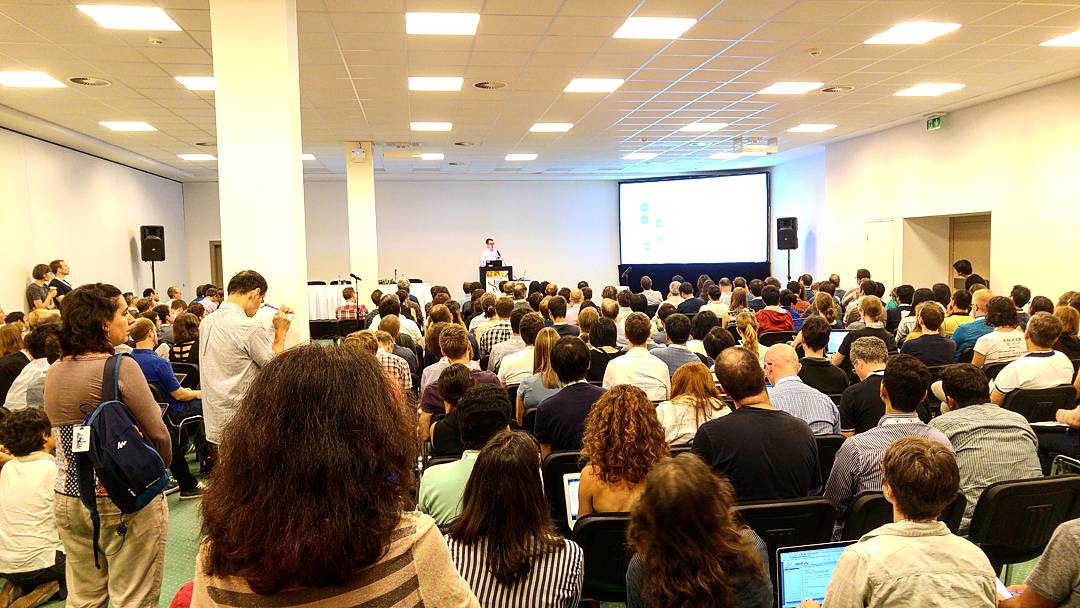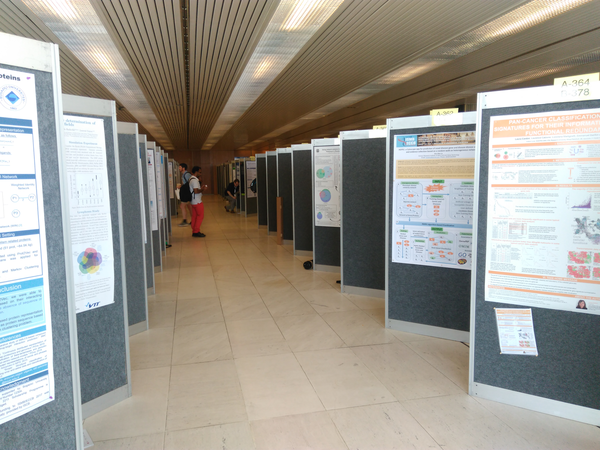ISMB/ECCB 2017, Prague, Czechia
This year in July I participated European Conference on Computational Biology held by ISCB in Prague Congress Centre. I was presenting a poster about E-cyanobacterium.org - A Web-based Platform for Systems Biology of Cyanobacteria.

Saturday (22.7.2017)
The first full day of ISMB/ECCB 2017 was filled with incredible science! Below are just some highlights from Saturday’s events!
For outstanding service contributions toward the betterment of ISCB through exemplary leadership, education, & or service, Alfonso Valencia awarded Fran Lewitter the well-deserved Outstanding Contributions to ISCB Award.
James Sharpe of EMBL-CRG Systems Biology Unit Centre for Genomic Regulation (CRG) in Barcelona, Spain gave an engaging speech on Dynamic computer modeling to span the scales: from molecular circuits to organogensis.
His talk focused on the predominant emphasis of genomics, bioinformatics and computational biology at the molecular scale, however many of the things we wish to understand occured at the macroscopic scale of organs and organisms: the development of a phenotype, the spread of a cancer, the regeneration of an organ. At the molecular scale, regulation of genes and proteins create a complex networks which control cell activities (division, migration, cell fate decisions, differentiation, and many others), with both an intracellular part (circuits of transcription factors) and an extracellular part (secreted ligands which move between cells allowing cell-cell communication, such as FGFs, WNTs, etc). The coordination of thousands of cells by this extended molecular network, leads to large-scale morphogenesis at the scale of tissues and organs. However, these large-scale tissue movements also feedback to the molecular scale: the movement of tissue regions relative to each other causes cells to receive dynamically changing concentrations of signaling molecules, and this in turn changes the activation or repression of genes and proteins.
Throughout the day, attendees were able to meet and seek out information on new technologies, platforms and ideas during three separate occasions.

Below are highlights from some COSI (Community of Special Interest) tracks that occurred that day:
CAMDA - analysis of heterogenous datasets
In front of a packed house, Lodewyk Wessels kicked off the first day of the CAMDA@ISMB track with an inspiring keynote on hierarchical integrative models and inference of cancer drug response. CAMDA was grateful to speakers coming to from 8 countries and the lively, engaged audience in the following CAMDA Neuroblastoma Data Integration Challenge session, discussing a variety of computational approaches for improving the prediction of clinical endpoints, identifying relevant markers, and elucidating molecular mechanisms, with methods spanning a wide range from multi-view kernel k-means, via stacked similarity network fusion, variation of information based layers of networks, to classical machine learning, sequence analysis, and cox hazard regression. In flash talks integrated with a matched poster session, the track explored cutting edge topics for both the neuroblastoma challenge as well as the CAMDA MetaSUB Inter-City Challenge, which will feature prominently again on Sunday - thank you all for making this exciting meeting such a success, and don’t forget to vote for the CAMDA Best Presentation Award!
SysMod - computational modelling of biological systems
The three SysMod sessions covered how to take into account the different levels of uncertainty affecting modelling and simulations, how to use modelling to understand gene regulation, signalling and response to drugs, and multi-scale modelling. A common theme crossing all three sessions was the variability, biological or experimental. The 13 speakers discussed how to make the most of it to maximise the accuracy and usefulness of computational models, and answered the many questions of a full Panorama Hall.
Sunday (23.7.2017)
ISCB 2017 Overton Prize Award Keynote, Christoph Bock, CeMM Research Center for Molecular Medicine of the Austrian Academy of Sciences in Vienna, Austria, gave a talk titled Bioinformatics for Personalized Medicine: Looking Beyond the Ge-nome focusing on the complexity of the human body requires trillions of individual cells to integrate, interact, and strike the right balance between stability and plasticity. Key mechanisms underlying this extraordinary feat of self-organization are encoded in the human genome, yet there are additional levels of regulation that are operate on top of the genomic DNA sequence, collectively referred to as the epigenome.
The talk drew a robust question and answer period from the audience culminating in an evocative and informative speech!
BD2K - Big Data to Knowledge
Big Data to Knowledge (BD2K) is a trans-NIH initiative established to enable biomedical research as a digital research enterprise, to facilitate discovery and support new knowledge, and to maximize community engagement. The special track was comprised of three sessions which were aimed at creating an overall objective to facilitate broad use of biomedical digital assets by making them Findable, Accessible, Interoperable, and Reusable (FAIR); to conduct research and develop the methods, software, and tools needed to analyze biomedical Big Data; to enhance training in the development and use of methods and tools necessary for biomedical Big Data; and to support a data ecosystem that accelerates discovery as part of a digital enterprise. Two sessions of talks focused on addressing these objectives in the fields of machine learning and in metadata and indexing. The third session addressed topics and emerging technologies in data science, open science, and their relationship to the NIH Commons. The tracks concluded with a panel session to assist discussions about ongoing questions in biomedical research and data science.
Below are highlights from some COSI tracks that occurred that day:
RegGen - computational methods for studying the regulation of genes and systems
The Regulatory Genomics track offered many interesting presentations, including Jan Grau on DREAM Challenge results on de novo prediction of transcription factor binding sites, and Leelavati Narlikar on motif modules in ChIP-seq data. Cole Trapnell delivered a keynote talk entitled “Powering quantitative models of gene regulation in development with single-cell genomics” to a standing-room-only crowd at the Regulatory Genomics COSI.
BOSC - Bioinformatics Open Source Conference
BOSC Day 2 kicked off with a session on Community Building and Citizen Science, which began with a well-received talk about citizen science and the beer metagenome, followed by a session of Late-Breaking Lightning Talks. In the afternoon there were talks about Open Data, followed by a lively panel discussion: “Open Data: Standards, Opportunities, and Challenges” (OD-SOC). Finally, Nick Loman delivered the closing keynote on using sequencing and open data sharing to do real-time monitoring of Ebola and Zika outbreaks. See twitter.com/@OBF_BOSC for lots more about BOSC 2017, including highlights from Day 1 and the Codefest!
NetBio - methods and tools for network biology
The Network Biology COSI speakers and participants enjoyed an informative, and fun-filled day hearing about advances in network biology. The day included 23 talks (6 proceedings) and 96 posters! To end the day on a fantastic note, we enjoyed an inspiring closing plenary from Gary Bader, who talked about going from Genotype to Pathways to Phenotypes.
Monday (24.7.2017)
Opening the 3rd day of ISMB/ECCB 2017, Alfonso Valencia introduced the ISCB 2017 Class of Distinguished Fellows who each were congratulated with a plaque and official ISCB Fellow pin!
Capping off the morning, distinguished keynote, Zhiping Weng from the University of Massachusetts Medical School Worcester gave an engaging talk on ENCODE Encyclopedia: Featuring a Registry of Candidate Regulatory Elements and the Visualization Tool SCREEN for Searching Them, focusing on The Encyclopedia of DNA Elements (ENCODE) Consortium generating thousands of genomic datasets with the goal of annotating the functional elements in the human and mouse genomes.
Throughout the day, conference attendees were able to meet and seek out information on new technologies, platforms and ideas during three separate occasions for collaborating, networking and time with exhibitors.
The day finished with attendees perusing the odd numbered poster presentations of session B to hear about new concepts and ideas being presented.

The science might have ended for the day but elsewhere in Prague, over 700 participants gathered at U fleku to network, connect and raise money for travel fellowship funding.
Below are highlights from a COSI track that occurred that day:
BioVis - visualization of biological data
The BioVis 2017 COSI meeting showcased a broad range of data visualization research in biology, spanning an impressive spectrum of talks that covered visualization approaches for omics data, protein and other molecular structures, as well as neuroimaging data. Two keynotes that highlighted the gamut of open challenges that are relevant to the BioVis community framed the event. Boudewijn Lelieveld of Leiden University Medical Center (The Netherlands) presented significant technological advances in visual analytics for spatial transcriptomics and deep biological insights across single cells and tissue data. Miriah Meyer from the University of Utah Scientific Computing and Imaging Institute presented an inspiring talk about her ongoing research into scientific approaches for applied data visualization projects.
Tuesday (25.7.2017)
Capping off 4 days of ISMB/ECCB 2017, the final day of the conference began with COSI sessions, followed by the even numbered poster presentation of session B. Attendees had most of the day to soak up the final talks, presentations and sessions in addition to meeting with the exhibitors before the final keynote and awards presentation of the conference!
ISCB 2017 Senior Scientist Award Keynote Pavel Pevzner from the University of California San Diego took to the stage as the fifth and final keynote, delivering a talk entitled Bioinformatics: a Servant or the Queen of Molecular Biology? His speech focused on “While some experimental biologists view bioinformatics as a servant, I argue that it is rapidly turning into the queen of molecular biology. I will illustrate this view by showing how some recent computational developments brought down biological dogmas that remained unchallenged for at least three decades. Finally, I will discuss a century-old dogma and describe the recent efforts to repudiate it.”
Below are highlights from some COSI tracks that occurred that day:
TransMed - computational approaches in clinical and translational medicine
In the TransMed COSI track at ISMBECCB2017 meeting, current status of computational biology and bioinformatics approaches solving both theoretical and practical challenges in translational medicine has been discussed. In this year’s TransMed, the talks were ranging from modelling disease progression, treatment prediction, (integrated) genome-phenome analysis in various disease areas to large human genome projects (UK 100K Genomes) and FAIR of data and services towards personalised medicine. Three keynote talks have provided new insights in new methodical approaches, outlined a major initiative to use genomics to bring benefit to patients within the health care system and brought us to the challenges and chances in open science and FAIR data and services. Contributed talks from the communities address new attempts and solutions in solving various disease related problems by building new methods, algorithms and analytics and including not only phenotypic and mulit-omics data but also imaging and temporal information.
Remarks
This year, over two thousand scientists participated on the conference, presenting approximately one thousand posters and giving plenty talks.
All recorded talks from ISMB/ECCB 2017 are be available on ISCBtv.
ISCB Summer newsletter & ISMB/ECCB 2017 Conference Program is available here.